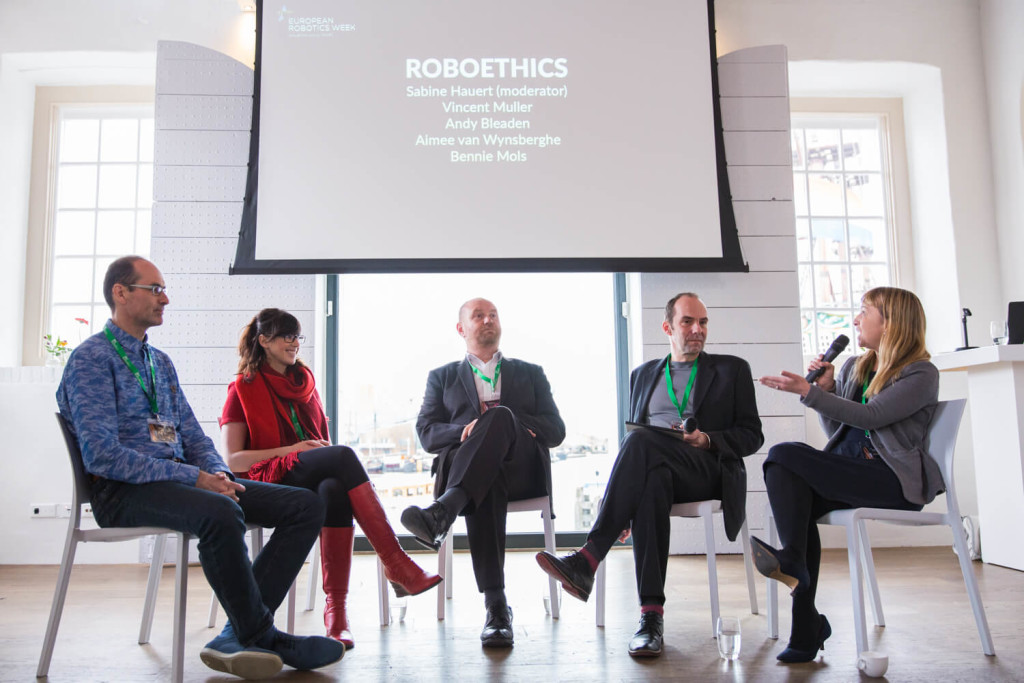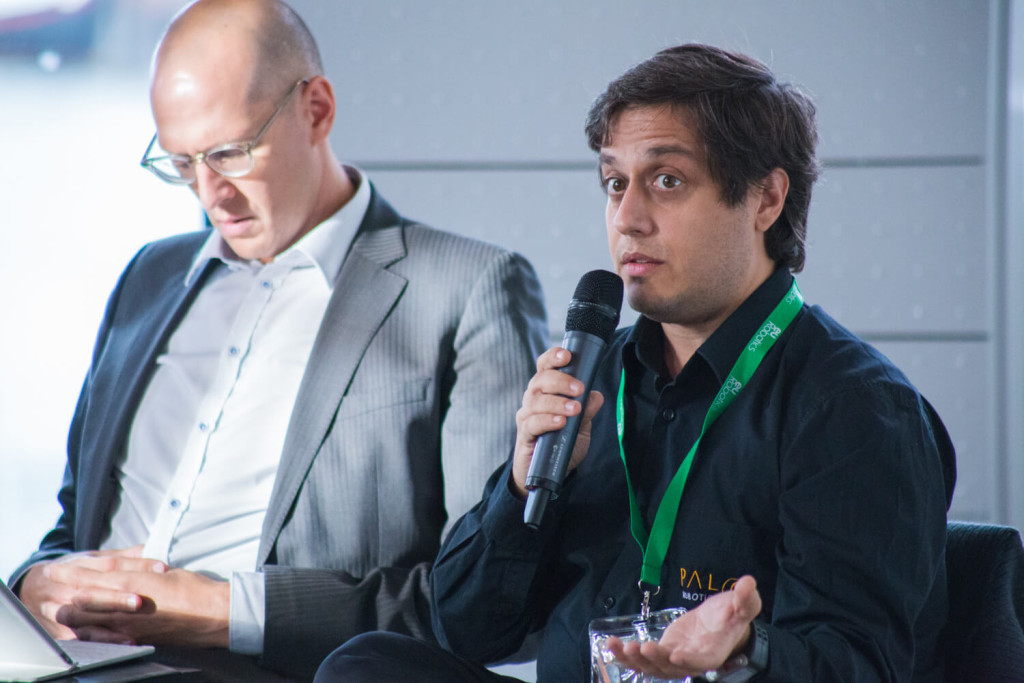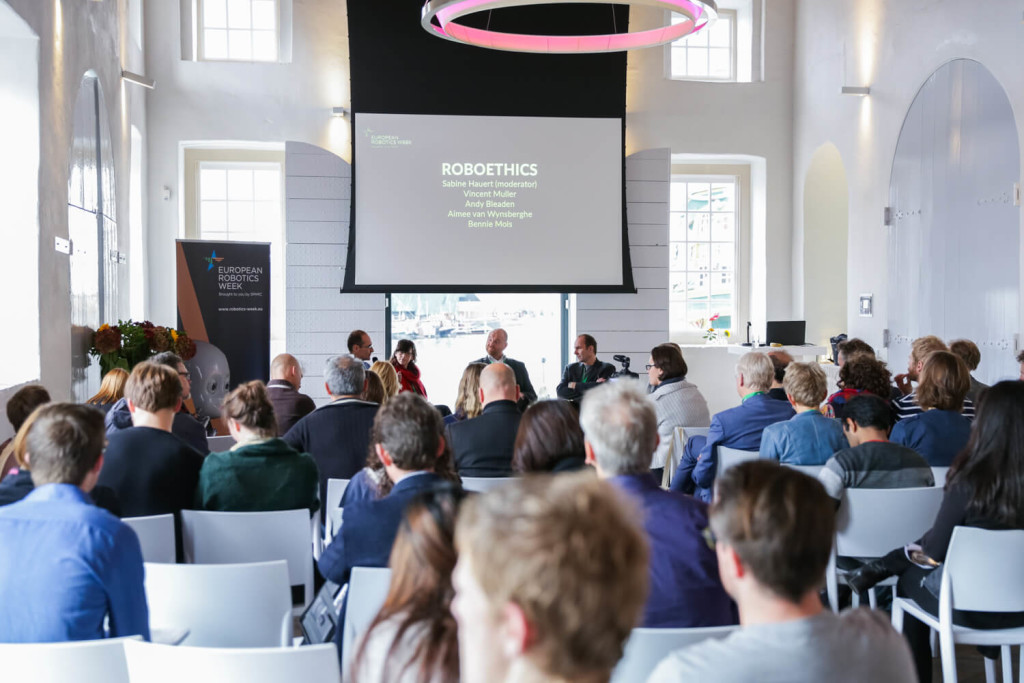
Robohub.org
Considering robot care, ethics & future tech at #ERW2016 European Robotics Week
What ethical issues do we face in providing robot care for the elderly? Is there better acceptance with the public? What should we be mindful of when designing human-robot interactions?
At the #ERW2016 central event, held in Amsterdam 18-22 November, these questions (and more) were discussed, debated, and encouraged by expert panellists hailing from research, industry, academia, and government as well as insightful members in the community. All were welcome to ‘Robots at Your Service’, a multi-track event featuring panel deliberations in robotics regulation, assistive living technologies, and aimed at attracting more youth, and especially girls, into science, technology, engineering, arts and maths (STEAM). The event hosted workshops and featured a 48-hour hackathon for designers, makers, coders, engineers, and anyone else who believed healthy ageing should be a societal challenge.
The first panel ‘Roboethics’ focussed on the role robots may have in elderly care and ethical implications. Should robots be regarded as tools, helping with administrative and manual tasks, and also as emotional support? The panel featured Sabine Hauert, (as moderator) President of Robohub and Lecturer at the Bristol Robotics Laboratory; Vincent Muller, Professor of Philosophy and University Academic Fellow at the University of Leeds; Andy Bleaden, Funding and Programmes Manager at Stockport Council with a background in social care; Aimee van Wynsberghe, Assistant Professor of Ethics and Technology at the University of Twente and co-founder of the Foundation for Responsible Robotics; and Bennie Mols, science and technology journalist with a special interest in artificial intelligence and robots.

Ethical issues in robot care – There was some initial discussion about ethical considerations in the area of robocare. Ethical in terms of the social-emotional impact of what and whether or not real “care” should come only from human-to-human contact. Some wondered if robots could provide real care, others thought they should continue filling tasks in the 3Ds (dirty, dull, and dangerous) and free up the human carer’s time to be physically/emotionally supportive with patients. Snippets from the panel discussion are below:
“It’s good to have robots specifically tasked on things we don’t want to be doing,” said Benny. “People want human attention. The human brain is really the social brain, we like to connect to other people. Care of people is the most difficult aspect.”
“We are testing robots for use with people who are living well with dementia,” said Andy. “People feel isolated. Dementia could have meant a form of “social leprosy” at one time, and this is now changing across Europe. I’m aware that we have nursing homes that fail regularly because of the standard of care [in the UK]. We are dealing with a lot of people who are feeling that they are isolated. Maybe we need to have that conversation about companionship with robots.”
“What should we be mindful of when designing human-robot interactions?” asked Sabine.
“There always needs to be a human in the loop making sure the human aspects are there,” said Aimee. “The robot is there to help fulfill their role as a caregiver.”
“Engaging people with activities is a really useful way to manage their thoughts and their day,” said Andy. “And it’s also fun. Maybe having an AI programme to engage people.”
“It’s important to consider how can we incorporate ethics into the design process of robots, that way we can have a more proactive approach,” said Aimee. “In a hospital, for example, someone is designated for that person’s care. How will this change when a robot is introduced into that chain?”
“One gentleman told me he’s much more inclined to have a robot nurse help him with showering and dressing, as opposed to a care worker,” said Andy.
“What does the public think about robots for eldercare?” said Sabine.
“One side thinks its creepy, one side thinks they will be great for everything,” said Bennie. “I think we’ll need to find something in the middle.”
“How do we decide these kinds of things?” said Aimee. “Is it by choice? How are we suppose to make a choice? Is it the majority, or by individual personal preferences? Or is it by the government?”
“The best way could be designating enough money to the local governments and letting them decide,” said Andy. “That way they can explore how to care for their citizens.”
An audience question enquired about whether an ‘ethical brochure’ or manual will be created. “We keep contemplating examples, but we need something,” he said. “You also discuss the elderly, but we can also talk about children. Is it ethically correct if a child forms a bond with a robot? What is the borderline between good/bad?”
“People attach value to things,” said Vincent. There are a few considerations: ethics doesn’t quite work like that. You do have to enable people to tackle ethical issues by themselves (empowering the individual). We are developing a position statement from this group.”
“Do we need an ethical framework to drive decisions?” asked Sabine.
“We need guidance to gauge what is it that we want to achieve,” said Vincent. “Some people may say ‘Okay, let’s economise this’. However, we need to ask ourselves: What are the best case consequences and how do we want to achieve this? What aims are we trying to achieve? How high is the percentage of people who need our support? If a robot can be programmed to be ethical, who decides that (roboticist or person). No one really knows the answer just yet. Machine ethics makes us question what ethics is. Do we give the robot life goals and preferences, so it understands consequences? Or, should the robot have decision-making skills so it’s safe and reliable? Lots of questions to consider.”

The second panel focussed on robotics in OUR future. How do we see robotics shaping in the next 10-20 years? The panel featured participants Uwe Haass, (as moderator) Senior Consultant with RoboConsult; Maarten Goos, Professor of Economics and Institutions at the Utrecht University School of Economics (U.S.E.); Francesco Ferro, CEO at Pal Robotics, Sabine Hauert, President of Robohub and Lecturer at the Bristol Robotics Laboratory; Vincent Muller, Professor of Philosophy and University Academic Fellow at the University of Leeds; and Anne Bajart, Programme Officer for the European Commission. Snippets from the panel discussion are below:
What can we expect with robotics in Our immediate future – “Robotics has been announced for many years as the ‘future’ technology. But the question is ‘OUR’ robotics future. Where do you see the future of robotics in general? In the next 10-20 years, or even in our lifetimes?” asked Uwe. “Are there new applications popping up?”
“Only a few years ago, people thought robots were too expensive and didn’t want to invest. Now it’s 3x different,” says Anne. “One thing is for sure. Robotics in our future need to be intelligent, otherwise, they won’t be very useful,” she said.
“In the next 10-20 years, I hope to see more robots in our homes,” said Sabine. “Making robots is hard, 10 years is not all that long — Dyson took 10 years of development to make their eye 360. My hope is that we do see several robots who are able to perform simple tasks, I don’t think we’re going to see Rosie the Robot [from the Jetsons], but I’m hoping in our lifetime these things will become a reality. ”
“A few years ago, people were saying robotics was too expensive or people didn’t want to invest in robotics. Now, the situation is completely different. Why is this development now accelerating? Is it for profit, or is it altruism?” asked Uwe.
“Well, the difference is now that you have industrial robotics on the one hand and service robotics on the other,” said Martin. The price in industrial robotics has fallen and it’s adding more robots to the manufacturing processes. So now there’s both low-end services and high-end services.”
“Is there more acceptance with the general public because of service robots?” asked Uwe.
“The public is more inclined to accept robots,” said Vincent. “People are really curious to adopt these things. Children are even more willing to interact with robots. One type of robot that will enter into our lives fairly soon will be autonomous cars. I don’t expect it to be much of an issue. We won’t have terminator robots. I think the public is quite ready for it; it’s the ethical issues that pose an issue.”
“As soon as people see the need and the use of robots, people are less fearful,” said Anne. The never ending question is “will a robot take our job.” We shouldn’t be afraid of the change and should welcome it. Just like every other industrial change so long as we prepare for it and people are trained in the right skills.”
There was also discussion of the many advantages of conducting robotics within Europe. In part because of unique partnerships, like SPARC, but also the collaborative community working together. Indeed, the robotics community is starting to embrace a very global mindset and perhaps could do a bit more risk taking.
“Europe is getting more entrepreneurial. Will this be a barrier for further development?” asked Uwe.
“We definitely need more and more collaborations in the community of robotics manufacturers,” said Francesco. “We have excellent research in Europe. There’s a bit of fear with people losing ideas or competing for money. But there can absolutely be a sustainable business model for robotics which involves sharing.”
“Europe has a lot of advantages with lots of great companies,” said Anne. “Not everything that is the “best” comes out of the US. SPARC is a unique partnership with industry and academia working together. I don’t see why this isn’t just as a good as many companies in the States. I don’t believe in science in isolation. We have to accept that public funding is limited to a certain amount of people. We need to ensure that we are funding not just research, but also innovation.”
“I see a lot of vibrant startups in Bristol, for example, Open Bionics,” said Sabine. “There’s not a European or a US feel. Robotics has a very global mindset. I’m encouraged to see this in Europe. What is tricky is the investment side, there needs to be more risk-taking in Europe so startups feel they can stay in Europe.”
The panel closed with discussions that robotics should be for everyone, and that, not everybody involved in robotics has to be an engineer. No country should be left behind due to lack of technology. In the future, and in terms of how robotics will be, we will need to rethink what we place value on (for example education or health care) and help provide opportunities to everybody.
All images credit: Visual Outcasts
European Robotics Week is organised by euRobotics and brought together by SPARC, a partnership for robotics in Europe to help maintain and extend Europe’s leadership in robotics. ERW has attracted more than 200,000 people since 2011 to take part in robotics related activities. During the week, research institutes, universities, industry, and activities are open to the public to engage and learn more about robotics.
tags: c-Events, European Robotics Week 2016, Robots at your Service, SPARC





